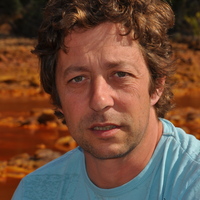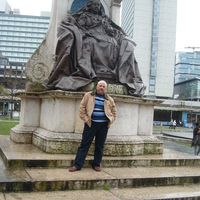Papers by Conrad Lindholm
International Journal of Rock Mechanics and Mining Sciences & Geomechanics Abstracts, 1995
Bulletin of the Seismological Society of America, Feb 1, 1992
... BY J. HAVSKOV, LB KVAMME, RA HANSEN, H. BUNGUM, AND CD LINDHOLM ... On this background, a coo... more ... BY J. HAVSKOV, LB KVAMME, RA HANSEN, H. BUNGUM, AND CD LINDHOLM ... On this background, a cooperative effort, supported by the petroleum industry, was initiated in 1985 between the University of Bergen and NORSAR to install and operate a regional network ...
Proceedings, May 29, 1995

EGU General Assembly Conference Abstracts, Apr 1, 2012
ABSTRACT The postglacial structures in northern Fennoscandia are remarkable expressions of up to ... more ABSTRACT The postglacial structures in northern Fennoscandia are remarkable expressions of up to magnitude 8 earthquakes in a presently stable region. The Stuoragurra Fault in northern Norway is one of these faults that can be traced for a length of 80 km. The Sautso dam in the Alta river is the largest concrete arch dam in Norway and is located only 15 km from the Stuoragurra Fault. It is of course of great importance to reveal if this fault has the capacity to release another major earthquake. The ARCES seismic array is located some 60 km from the Stuoragurra Fault and has recorded signals that demonstrate a weak seismic activity along the fault zone. However, the spatial resolution of these recordings is too low to resolve a detailed location or foal depth determination. In an attempt to understand more of the present day activity, three 3-component high-frequency seismic stations have been deployed near Masi for continuous recording during the fall and winter of 2011/2012. We will present the preliminary results from this mini-network placed on top of the presumed active fault.

Bulletin of the Seismological Society of America, Aug 1, 1990
Abstract The northern North Sea is one of the most seismically active regions of Northwest Europe... more Abstract The northern North Sea is one of the most seismically active regions of Northwest Europe, but offshore seismicity is difficult to study in detail because the severe environment places limits on options for deployment of near-field ocean bottom seismometers (OBS). The design of an OBS system deployed on the Statfjord oil field is presented, together with some results. Amplitude density spectra of ambient noise from two OBS installations are on average more than a factor of ten higher than the average of three onshore Western Norway Network (WNN) seismic stations. A theoretical detection threshold curve, based on background noise levels, is in close agreement with practical experience of detections at the Statfjord OBS and explains why only about 7 per cent of the events detected in the northern North Sea by the WNN are also detected on the Statfjord OBS. Comparison of earthquake source spectra, recorded on and off shore, reveal no evidence for either high attenuation or amplification in the Viking Graben. Earthquake focal depths in the central northern North Sea seem to be around 20 km.
Seismological Research Letters, Nov 1, 2000
... the platforms should be designed to resist total collapse for an earthquake load with probabi... more ... the platforms should be designed to resist total collapse for an earthquake load with probability of exceedance of 10 -4 per year. ... The seismicity offshore of Norway (Figure 1) follows the passive continental margin over more than 1,000 km (Byrkjeland et al., 2000), extending into ...
AGU Spring Meeting Abstracts, May 1, 2013
Bulletin of the Seismological Society of America, Jun 1, 1993
... Other works on 3-C phase identification (Suteau-Henson, 1991; Riviere-Barbier et al., 1992) g... more ... Other works on 3-C phase identification (Suteau-Henson, 1991; Riviere-Barbier et al., 1992) gave that careful studies of polarization characteristics at each individual station are necessary to achieve useful results. ... Page 9. 668 BO RUUD, CD LINDHOLM, AND ES HUSEBYE ...
EGU General Assembly Conference Abstracts, Apr 1, 2015

Physics And Chemistry Of The Earth, Parts A/b/c, Oct 1, 2021
Abstract In Probabilistic Seismic Hazard Analysis (PSHA), a widely used approach to model earthqu... more Abstract In Probabilistic Seismic Hazard Analysis (PSHA), a widely used approach to model earthquake sources consists of using homogenous source zones. This approach suffers the limitation of assuming that the observed seismicity can occur anywhere with same probability over a specific area, which might lead to the potential undervaluation of the predicted ground motion level due to an effect of smearing of seismic potential. To compensate that, a hybrid model is used, accounting both for distributed seismicity and localized seismogenic structures. In this study, we perform PSHA for Northeast India and Bhutan, that are the most seismically hazardous regions on the planet. The region was partitioned into seismogenic source zones of supposedly homogeneous seismic potential and seismotectonic characteristics. Earthquake recurrence parameters for each zone were obtained from direct magnitude-frequency analysis on a precompiled global catalogue. Seismogenic faults are added to the model by converting slip rates from GPS velocity data to seismic activity. Complementary information was derived from the analysis of moment tensor solutions of large events and from a detailed literature review. Using this hybrid model, seismic hazard was calculated for a region bounded by lat/long 24.0°-28.8°N/88.0°-94.5°E. Calculations were performed for Peak Ground Acceleration (PGA) and several Spectral Acceleration (SA) periods for a Probability of Exceedance (POE) of 10% in 50 years, corresponding to 475 years return period, and for a reference rock condition with Vs = 800 m/s. The results highlight significant acceleration levels (about 0.77g at PGA) in the Arunachal Pradesh region (Northeast India), due to the presence of the Himalayan Frontal Thrust (HFT).
Springer tracts in civil engineering, Jun 8, 2022
Seismological Research Letters, 1992
The Washington Regional Seismograph Network (WRSN) earthquake catalog shows more earthquakes in t... more The Washington Regional Seismograph Network (WRSN) earthquake catalog shows more earthquakes in the day than at night, probably because some local explosions are misidentified as earthquakes. We have implemented a method to help discriminate likely local blasts from local earthquakes. Probable blasts are identified based on time of occurrence (year, month and hour), magnitude, location, and depth. We have defined thirteen areas in Washington and northern Oregon, with enhanced daytime activity probably due to blasts, and have developed specific time, magnitude, and depth criteria for each area to best identify probable blasts. Except in a few regions, most of the smallest, shallowest events occurring during the day in Washington and northern Oregon are probably blasts.

Journal of Asian Earth Sciences, 2017
In this study we compare Himalayan seismic moment release estimates derived from strain rate obse... more In this study we compare Himalayan seismic moment release estimates derived from strain rate observations with those derived from large historical earthquakes, and to this end we use a reassessed catalogue of historical earthquakes from western and central Himalaya since the beginning of the 16th century. We have computed seismic moment rates within six contiguous segments along the Himalayan arc and compared these, using Kostrov's formula, with moment rates computed from recent global strain rate estimates and regional studies. While the ratios between strain-based moment-rate estimates and those inferred from observed seismicity vary significantly between the segments, we find on the average consistently larger strain-based values by about a factor of two, based on seismicity from the last 515 years. The moment-rate ratio is, however, significantly reduced when shorter catalogues are used, to 1.28 for the last 215 years and to 1.05 for the last 115 years, which is an almost perfect match. The possible inclusion of afterslip in the model would further improve the 515-year match. This is indicating that a significant part of the difference, possibly most of it, is likely to be caused by incompleteness of the longer earthquake catalogue, possibly combined with underestimated magnitudes. The difference between geodetic and seismic estimates for the more complete part of the catalogue is smaller than previously reported along the western Himalayan frontal thrust. In fact, the only region where a significant moment-rate difference is found in our study is in SE Himachal Pradesh. In terms of seismic hazard it is found that the moment rate reduction of about a factor of two, when going from 115 to 515 years, leads to a reduction in the 475-year PGA of about 26%. It is also found that using 50 years of USGS seismicity data between 1963 and 2012 leads to a 40% lower hazard as compared to using moment release for the last 115 years.
Bulletin of Earthquake Engineering, 2011
... 1. The first site, NGA, is located almost 40 km SE of Dehradun, and is characterized by young... more ... 1. The first site, NGA, is located almost 40 km SE of Dehradun, and is characterized by young sedimentary basins filled with sediments of Doon gravels (Singh et ... The real array response depends also on the slowness and the wavenumber, k, of the seismic phases observed ...

ABSTRACT Ranafjorden, in northern Norway, is a region with increased seismic activity relative to... more ABSTRACT Ranafjorden, in northern Norway, is a region with increased seismic activity relative to the other parts of Fennoscandia. A six-station seismic network detected in a two-year period c. 300 earthquakes in the area, often occurring as swarms. Fault plane solutions indicate E-W extensional faulting. The outer Ranafjorden district is also the location for the largest earthquake recorded in Fennoscandia in historical times, i.e. the c. 5.8 magnitude in 1819. Liquefaction structures in the postglacial overburden points to the likely occurrence of large, prehistoric earthquakes in this area. Three measurements of uplift of acorn barnacle and bladder wrack marks on the islands of Hugla and Tomma in the outer Ranafjorden area show anomalous low land uplift from 1894 to 1990 (0.0-0.07m) compared with the uplift recorded to the north and south (0.23-0.30 m). An irregular relative subsidence pattern in the order of 1-2 mm/year is also observed on INSAR permanent scatterer data in the same area. The relatively low seismicity occurring at a depth of 2-12 km could, therefore, create the observed irregular subsidence pattern at the surface. We have established a Global Positioning System (GPS) network to measure the active geological strain in the Ranafjorden area. Three 15-20 km-long profiles were located across outer, central and inner Ranafjorden. The GPS stations along the western profile seem during the period from 1999 to 2008 to have moved c. 1 mm/year to the NW relative to the stations along the two eastern profiles. Plio-Pleistocene sedimentary wedges on oceanic crust in the Lofoten and Norway basins are co-located with seismic activity. Along the coast of northern Norway there is a parallel and shallow zone of increased seismicity, which largely reflects extensional stress conditions. Considering that the Plio-Pleistocene loading of the relatively stiff oceanic crust causes seismicity in the Norwegian Sea, it is also likely that a comparable unloading of the coastal areas in western and northern Norway may induce extension and accompanying earthquake activity. Some of the earthquake clusters in the Hugla and Sjona area are located along N-S trending fracture zones with escarpments facing to the west. They are most likely formed by glacial plucking of the bedrock along the fractures by the moving inland ice. Ice-plucking features may, however, be indirectly related to neotectonics. Moving glaciers in the Canadian Cordillera tend to pluck bedrock along extensional fractures parallel to the direction of maximum horizontal stress. The Pleistocene glaciers could, in a similar way, cause a higher degree of bedrock plucking by basal glacier shear along favourably oriented fractures in areas with highly anisotropic rock stress. It is highly likely that the deeply weathered basement rocks as we find on either side of Vestfjorden today extended farther south along the Nordland coast prior to the exhumation in the Plio-Pleistocene. The unloading of the crust in these coastal areas could have resulted in flexuring and accompanying fracture extension. The deeply weathered and fractured basement rocks could have facilitated effective glacial erosion during the c. 40 glaciations during the Pleistocene. Freezing and thawing combined with abrasion by ocean waves during non-glaciated periods would have assisted in the formation of a relatively wide strandflat along the Nordland coast.

Geophysical Journal International, 2015
We investigate the influence of the glacial isostatic adjustment (GIA) on the deformation at the ... more We investigate the influence of the glacial isostatic adjustment (GIA) on the deformation at the surface and at seismogenic depths in Fennoscandia. The surface strain rate field, derived from geodetic data, is controlled by GIA which causes NW-SE extension of up to 4 × 10 −9 yr −1 in most of mainland Fennoscandia, surrounded by regions of radial shortening towards the centre of uplift. The seismic deformation field, derived from a new compilation of focal mechanisms, shows consistent NW-SE compression on the Norwegian continental margin and a tendency towards tension in mainland Fennoscandia. The seismic moment rate is at least two orders of magnitude smaller than the geodetic moment rate. We propose that the low level of seismicity and the tendency towards tensional focal mechanisms in mainland Fennoscandia may be explained by the destructive interference of the regional stress from ridge push with the flexural stress due to GIA.
EGU General Assembly Conference Abstracts, Apr 1, 2015

The study aims to develop a new 3-D crustal velocity model for both onshore and offshore Norway. ... more The study aims to develop a new 3-D crustal velocity model for both onshore and offshore Norway. The work is being performed as a part of both the Norwegian National Seismic Network (NNSN) and the NEONOR2 projects. An extensive database was created using seismic data from both permanent and temporary seismic stations from different field deployments within Norway. The territory of Norway was divided into several parts and the studies were performed separately for each part in two steps: 1) the optimal 1-D velocity models have been obtained using the VELEST program, which is implemented into the SEISAN program package, 2) full 3-D tomography was performed using the FMTOMO program with the optimal 1-D velocity models as reference models. We thoroughly examined the resolution of inversions and defined its proper parameters. The inversion results show different variations in the distribution of seismic P-wave velocities within different parts of Norway.










Uploads
Papers by Conrad Lindholm